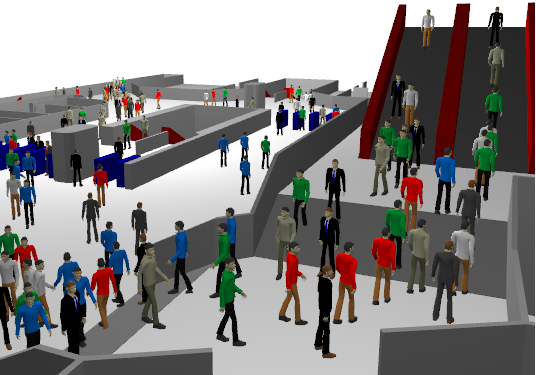

The contractors paid particular attention to the model’s interface.

It also implied that spending too much time without observing artworks moved a visitor to a progressive state of dissatisfaction that, at its maximum peak, forced them to exit the gallery. According to exhibition organizers, it was vital to consider visitors' specific features, including, preferences, goals, interest in the exhibition, mood, and others. The last step deserves greater attention. While people walked through the artworks, they got tired, until they reached a threshold level that forced them to stop as soon as they reached a rest area. Visitors demonstrated different involvement degrees towards the exhibition, and this affected time and effort spent in the gallery.(For example, look at the masterpiece from a particular location). To consider an artwork observed, visitors had to follow the rules particular to each artwork. While moving along the gallery, visitors established connections with the artworks, which are modeled as agents as well.Visitors joined a group that has not yet reached its maximum size and move along the gallery’s areas, trying to observe a greater number of artworks.Visitors entered the gallery according to a defined schedule, without knowing the artworks exhibited.The visitors’ walkthrough is described below:

It should be mentioned that the agents’ parameters were taken from surveys of people who visited other galleries, to make the model more accurate.

ANYLOGIC PEDESTRIAN LIBRARY HOW TO
In the end, engineers were able to reproduce the behavior of a person, roaming inside an area they didn’t know, with some simple goals to be reached, but with no specific supports on how to reach them.
Physical state of a visitor (fresh, tired, relaxed), and preferences for some artworks rather than others. Mood, affected by anxiety, proximity of other visitors, achievements in observing artworks, and other variables. Involvement rate, which was based on time spent per artwork and inside the gallery. Thanks to the library, it was possible to join the advantages of pedestrian dynamics with the power of the agent-based modeling approach, providing visitors with specific features and behaviors, and allowing visitors to interact with artworks. This library allowed modelers to simulate the behavior of agents (representing visitors), moving according to predetermined rules, and adjust distance and speed according to the crowd density. The movement of visitors inside the gallery was modeled with the help of the AnyLogic Pedestrian library. Visitors’ satisfaction, measured in terms of artworks observed. Pathway of each visitor inside the gallery. Percentage of artworks that could be observed. Presence of critical areas (too high or too low density of visitors). It let engineers see where the artworks could be placed, as well as show how people could move inside the gallery.ĭifferent layouts were tested, including: That’s where AnyLogic simulation modeling was advantageous. The contractors were supposed to provide a layout where artworks would be placed in hidden areas, so that it would be difficult to find them. To achieve that, they created a maze-like area in the museum, instead of ordinary canvas filled rooms, to affect the visitors’ moods. The general purpose of the project was to steer visitors’ attention by designing brand new personal experiences and novel curatorial approaches at the exhibition. Fair Dynamics, a Milan based consulting company with a distinct aspect towards simulation modeling, was engaged in developing The Ametria project, a contemporary art exhibition held in the Athens’ Benaki Museum.








 0 kommentar(er)
0 kommentar(er)
